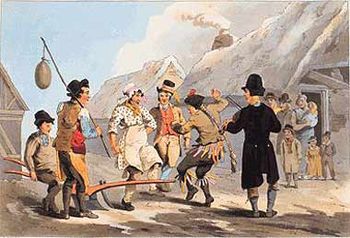
Plough Monday
Encyclopedia

Epiphany (Christian)
Epiphany, or Theophany, meaning "vision of God",...
, 6 January. References to Plough Monday date back to the late 15th century. The day before Plough Monday is sometimes referred to as Plough Sunday
Plough Sunday
Plough Sunday is a traditional English celebration of the beginning of the agricultural year that has seen some revival over recent years. Plough Sunday celebrations usually involve bringing a ploughshare into a church with prayers for the blessing of the land. It is traditionally held on the...
.
The day traditionally saw the resumption of work after the Christmas period. In some areas, particularly in northern England and East Anglia, a plough
Plough
The plough or plow is a tool used in farming for initial cultivation of soil in preparation for sowing seed or planting. It has been a basic instrument for most of recorded history, and represents one of the major advances in agriculture...
was hauled from house to house in a procession, collecting money. They were often accompanied by musicians, an old woman or a boy dressed as an old woman, called the "Bessy", and a man in the role of the "fool
Clown
Clowns are comic performers stereotypically characterized by the grotesque image of the circus clown's colored wigs, stylistic makeup, outlandish costumes, unusually large footwear, and red nose, which evolved to project their actions to large audiences. Other less grotesque styles have also...
". 'Plough Pudding' is a boiled suet pudding, containing meat and onions. It is from Norfolk and is eaten on Plough Monday.
William Hone made use of Observations on the popular antiquities of Great Britain: Including the Whole of Mr. Bourne's Antiquitates Vulgares (1777) by the antiquary John Brand
John Brand
John Brand was an English antiquarian.Born in Washington, County Durham, he was educated at the Royal Grammar School and Lincoln College, Oxford. He wrote Observations on the popular antiquities of Great Britain: Including the Whole of Mr. Bourne's Antiquitates Vulgares , generally referred to as...
. Brand's work (with additions by Henry Ellis
Henry Ellis (librarian)
Sir Henry Ellis was an English librarian.He was born in London and educated at the Mercers' School and St John's College, Oxford, where he acted as an assistant at the Bodleian Library...
) mentions a northern English Plough Monday custom also observed in the beginning of Lent
Lent
In the Christian tradition, Lent is the period of the liturgical year from Ash Wednesday to Easter. The traditional purpose of Lent is the preparation of the believer – through prayer, repentance, almsgiving and self-denial – for the annual commemoration during Holy Week of the Death and...
. Evidently the Plough dance depicted by Phiz in his illustrations for Harrison Ainsworth's 1858 novel Mervyn Clitheroe, and Ainsworth's description, is based on this or a similar account:

In the Isles of Scilly
Isles of Scilly
The Isles of Scilly form an archipelago off the southwestern tip of the Cornish peninsula of Great Britain. The islands have had a unitary authority council since 1890, and are separate from the Cornwall unitary authority, but some services are combined with Cornwall and the islands are still part...
, locals would cross-dress and then visit their neighbours to joke about local occurrences. There would be "goose dancing
Guise Dancing
Guise dancing is a folk practice celebrated between Christmas Day and Twelfth Night in Cornwall, UK...
" and considerable drinking and revelry.
The Plough Monday customs declined in the 19th century but have been revived in the 20th. They are now mainly associated with Molly dancing
Molly dance
Molly dancing is a form of English Morris dance, traditionally done by out of work ploughboys in midwinter in the 19th century.-History:Molly dancing has been recorded in many parts of the English Midlands and East Anglia. It died out finally in the 1930s, the last dancers seen dancing in Little...
and a good example can be seen each year at Maldon in Essex.

